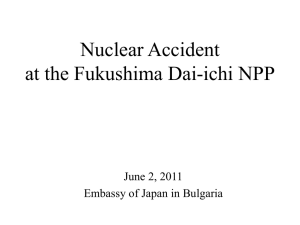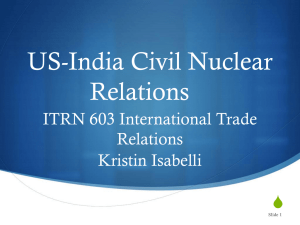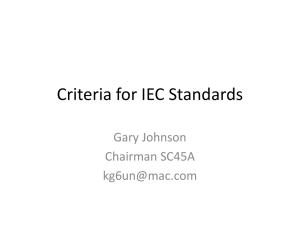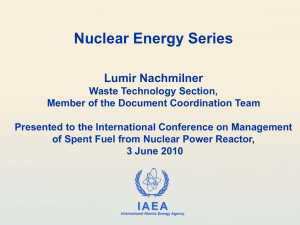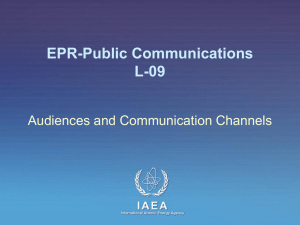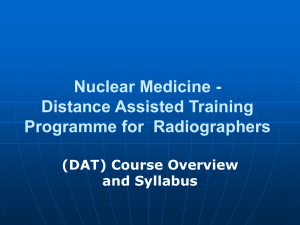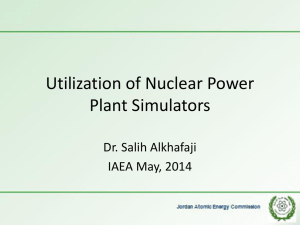IAEA
advertisement
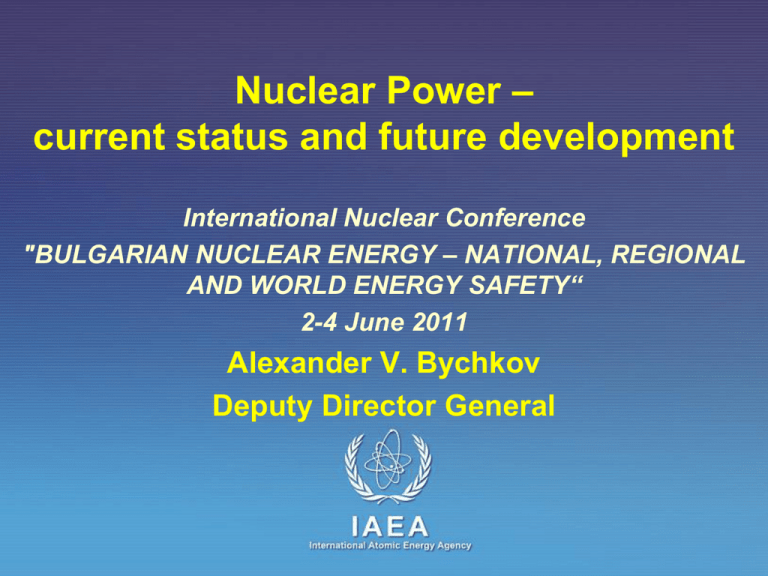
Nuclear Power – current status and future development International Nuclear Conference "BULGARIAN NUCLEAR ENERGY – NATIONAL, REGIONAL AND WORLD ENERGY SAFETY“ 2-4 June 2011 Alexander V. Bychkov Deputy Director General IAEA International Atomic Energy Agency IAEA and Nuclear Power “The Agency has a key role to play in ensuring that this expansion in nuclear power takes place in an efficient, responsible and sustainable manner. “…countries should be able to introduce nuclear power knowledgeably, profitably, safely and securely. .” Yukiya Amano Director General IAEA 2 “The Medium Term Strategy 2012-17” A. “Facilitating access to nuclear power.” B. “Strengthening promotion of nuclear science, technology, and applications.” C. “Improving nuclear safety and security.” D. “Providing effective technical cooperation.” E. “Strengthening the effectiveness and improving the efficiency of the Agency’s safeguards and other verification activities.” F. “Providing efficient, innovative management and strategic planning,” IAEA “Facilitating access to nuclear power” • The Agency should respond to growing interest in nuclear power, both from newcomers and from countries with existing nuclear power programmes, with all stages of the fuel cycle. • “Member States will discuss the development of multilateral approaches to the nuclear fuel cycle, including the possibility of creating voluntary mechanisms for assurance of nuclear fuel supply, as well as possible schemes dealing with the back-end of the fuel cycle.” • The Agency should help Member States: • to build capacities in nuclear science, energy systems analysis, engineering evaluations, project management and long term planning; • to support innovations in all areas of nuclear power; and • to assist throughout all stages of research reactor applications. IAEA Structure of global electricity supply Other Ren Biomass 1.5% Hydro 15.9% 1.3% Global electricity generation in 2008: 20 180 TWh Coal 41.0% Nuclear 13.5% Natural gas IAEA21.3% Oil 5.5% The Role of Nuclear Power in the Future Energy Mix • Continued growth in global energy demand • Energy security • Price volatility • Environment protection and climate change Nuclear power: • Improved operations, good economics and safety record starting In spite of economic crisis: in the early 1990s Prospects better than IAEA ever since the mid 1990s Impact of a doubling of resource prices 80 70 Base costs Double resource costs US$ per MWh 60 50 40 30 20 10 0 IAEA Nuclear Coal Natural gas 2010 – From rising expectations to renaissance? • 442 reactors in operation, up from 437 at the end of 2009 • 374 GWe total installed capacity, up from 371 GWe at the • • • • GWe • end of 2009 400connected to the grid, up from 2 in 2009 5 new reactors and 0 in 2008350 2 reactor shutdowns in 2010, and 2 in 2009 300 12 new construction starts; compared to 12 in 2009 and 10 250 in 2008 200 24 of 29 operating countries are considering expansion 150ordered their first NPPs 2 “newcomers” 100 50 IAEA 0 8 Distribution of NPPs IAEA 9 What will the renaissance look like? • Take place mostly in countries that already have nuclear power • Low projection: ~ 10 new countries by 2030 • High projection: ~25 new countries by 2030 • Just keeps pace with overall electricity growth • Most of the growth expected in Asia IAEA 10 Fukushima… IAEA IAEA Ministerial Conference on Nuclear Safety • The IAEA and Director General Mr.Amano have proposed that an IAEA Ministerial Conference on Nuclear Safety should take place from June 20 to 24 in Vienna. • The Conference goals: • to make a preliminary assessment of the Fukushima Daiichi accident, • to discuss ways of strengthening emergency preparedness and response • to review nuclear safety generally. IAEA IAEA DG Y.Amano about safety: • Harmonisation of the many valuable safety instruments • • • • which we already have Regulatory bodies must be further strengthened The IAEA system of expert peer review missions could be strengthened and expanded Technological developments, such as the introduction of next-generation reactors with stronger reliance on inherent safety features, will be an important driver of enhanced safety in the coming years. The IAEA can play a key role in coordinating national efforts to promote ever safer nuclear energy technology. IAEA Safety First • Safety First, • • • • when countries review their existing nuclear power plants, when they build new plants, when engineer innovative new reactors. when countries contemplate introducing nuclear technology for the first time and when established users consider expanding their programmes. • Safety First must also be our guiding principle as we examine ways of strengthening nuclear safety globally. • The main driver of the enhanced safety is naturally the technology IAEA Nuclear power landscape, May 2011 Operating IAEA Considering Expressing interest Negative Delaying 15 IAEA – LOW Projection 900 800 700 GW(e) 600 history 2005 500 2006 2007 400 2008 2009 300 2010 200 100 0 IAEA 1960 1970 1980 1990 2000 2010 2020 2030 IAEA – HIGH Projection 900 800 700 GW(e) 600 history 2005 500 2006 2007 400 2008 2009 300 2010 200 100 0 IAEA 1960 1970 1980 1990 2000 2010 2020 2030 World Reactors Distribution IAEA 4/13/2015 18 World Reactor Types IAEA 19 Proposed Nuclear Power Plants The number of planned NPPs for construction is based on the low demand estimate consistent with the strategy of sustaining the nuclear energy utilization at the level of 2007 IAEA 4/13/2015 20 Classification of Nuclear Reactors Generation I Generation II Generation III Generation III+ Generation IV Early phase: Shippingport, Dresden, Fermi I, Magnox Most operating reactors: LWR (PWR, BWR), CANDU, VVER, RBMK, AGR Improved designs: ABWR, AP600, System 80+, EPR, EC6 Evolutionary design with improved economics: AP1000, EPR1000, ACR1000 Highly economic, enhanced safety, minimize waste, proliferation resistant Gen I 1950 1960 Gen III Gen II 1970 1980 1990 2000 Gen III+ 2010 2020 Many definitions 1. EPRI – Guidelines for developing Third Generation reactors IAEA 2. WNA - Definition of a Gen III reactor Gen IV 2030 4/13/2015 21 Summary of Gen 3(+) Attributes EPRI: WNA : 1. Simplification 2. Design Margin 3. Human Factor 4. Safety 5. Design Basis Versus Safety Margin 6. Regulatory Stabilization 7. Standardization 8. Proven Technology 9. Maintainability 10. Constructability 11. Quality Assurance 12. Economics 13. Sabotage Protection and Good 1. Standardized design 2. Simpler and more rugged design 3. Higher availability and longer operating life 4. Reduced possibility of core melt accidents 5. Resistance to serious damage 6. Higher burn-up, Burnable absorbers(“poisons”) 7. Incorporation of passive or inherent safety features 8. Designed for load-following 9. Harmonized licensing as designs are more standardized Neighbour IAEA 4/13/2015 22 Advanced Reactors Country and developer Reactor US-Japan (GE-Hitachi, Toshiba) ABWR USA (Westinghouse) AP600 AP1000 (PWR) Europe (Areva NP) EPR US-EPR (PWR) Size MWe gross Design Progress Main Features (improved safety in all) 1380 - Evolutionary design Commercial operation in Japan since 1996-7. In US: - More efficient, less waste NRC certified 1997, FOAKE - Simplified construction (48 months) and operation 600 1200 AP600: NRC certified 1999, FOAKE AP1000 NRC certification 2005, under construction in China, many more planned there Amended US NRC certification expected Sept 2011 - Simplified construction and operation - 3 years to build - 60-year plant life 1750 Future French standard French design approval Being built in Finland, France & China Undergoing certification in USA - Evolutionary design - High fuel efficiency - Flexible operation USA (GE- Hitachi) ESBWR 1600 Developed from ABWR, undergoing certification in USA, likely construction there - Evolutionary design - Short construction time Japan (utilities, Mitsubishi) APWR US-APWR EU-APWR 1530 1700 1700 Basic design in progress, planned for Tsuruga US design certification application 2008 - Hybrid safety features - Simplified Construction and operation IAEA 4/13/2015 23 Advanced Reactors contd. Country and developer Reactor South Korea (KHNP, derived from Westinghouse) APR-1400 (PWR) Europe (Areva NP) Kerena (BWR) Russia (Gidropress) VVER-1200 (PWR) Size MWe gross 1450 1250 1290 Canada (AECL) Enhanced CANDU-6 750 Canada (AECL) ACR 700 1080 China (INET, Chinergy) IAEA HTR-PM Design Progress Main Features (improved safety in all) Design certification 2003, First units expected to be operating c 2013. Sold to UAE. - Evolutionary design - Increased reliability - Simplified construction and operation Under development, pre-certification in USA - Innovative design - High fuel efficiency - Evolutionary design Under construction at Leningrad and Novovoronezh - High fuel efficiency plants 50-year plant life Improved model Licensing approval 1997 - Evolutionary design - Flexible fuel requirements - Evolutionary design Undergoing regulatory pre-project review in Canada - Light water cooling - Low-enriched fuel Demonstration plant due to start building at 2x105 Shidaowan (module) - Modular plant, low cost - High temperature - High fuel efficiency 4/13/2015 24 IAEA Medium Term Strategy on 2012-2017 “Technological breakthroughs and other unanticipated events will require adjustments between 2012 and 2017. The Agency will position itself to take prompt actions to seize the advantages of positive opportunities and minimize the adverse consequences of unexpected negative developments.” IAEA Fukushima Potential Impact NPP design impact Assessment of NPP safety robustness (design margins) Improvements of safety systems Expanding the DBA list of events and designing against some classes of BDBAs or combinations of DBAs Various NPP design changes for operating NPP, particularly for new builds Operational impact Assessment and improvements of the operating procedures Assessment and improvements of the SAMGs, and implementation of more rigorous training Nuclear energy economy and strategy Review of NPPs design, construction, operation, and energy cost Increase of energy cost in general (from all energy sources – global effect) More stringent requirements for siting of NPPs Longer schedule for obtaining construction licence and EA approvals Weakening of commercial interest for some reactor types that do not prove to have enough safety robustness, or which are not adequately protected against severe accidents (or not enough passive features) IAEA 4/13/2015 26 WANO & WENRA - Regulatory Changes WANO sent a request to all operating NPPs to perform assessment of the station safety robustness against severe accidents WENRA issued a request to perform a “stress test” for all operating and new build NPPs Emphasize on rare severe accidents with high consequences Potential regulatory changes More stringent regulatory requirements for new NPP designs More stringent requirements for operating NPPs and those that are planned for life extension More stringent requirements for NPP operation and maintenance Less tolerance for noncompliance issues in NPP operation Additional activities by the international regulatory agencies (particularly IAEA, WANO and WENRA) leading to more stringent monitoring and assessment of NPP design and operation (periodic safety assessments) New regulatory requirements and documentation with higher expectations Reconsidering the event frequency range for DBAs and BDBAs IAEA 4/13/2015 27 WENRA Stress Tests • Prescribed by the WENRA organization to evaluate NPP design robustness and safety margins against severe accidents • Licensees requested to conduct stress tests until Sep 2011; European Commission will prepare final report by Dec 2011 • Scope • Initiating events conceivable at the plant state • Severe earthquake • Severe flooding • Other extreme natural events, or combination of the above • Consequential loss of safety function • Loss of electrical power, including station blackout (SBO) • Loss of ultimate heat sink (UHS) • Combination of the above • Severe accident management issues • Means to protect from and manage loss of core cooling function • Means to protect from and manage loss of cooling function in the spent fuel pool • Means to protect from and manage loss of containment integrity IAEA 4/13/2015 28 Conclusions • Nuclear energy is extensively used in the world today as reliable • • • • base-load energy Nuclear energy planning at the low level demand involves building of significant number of new NPPs around the world • Highest rate of new builds is expected in Eastern Asia New advanced reactor designs known as Gen 3 and 3+ have emerged in recent years As a result of the Fukushima event in Japan, the advanced reactors will be subjected to additional level of scrutiny and design improvements and changes As a result of the Fukushima event, the regulatory requirements will become more stringent and demanding IAEA 4/13/2015 29 Thank You for attention IAEA
